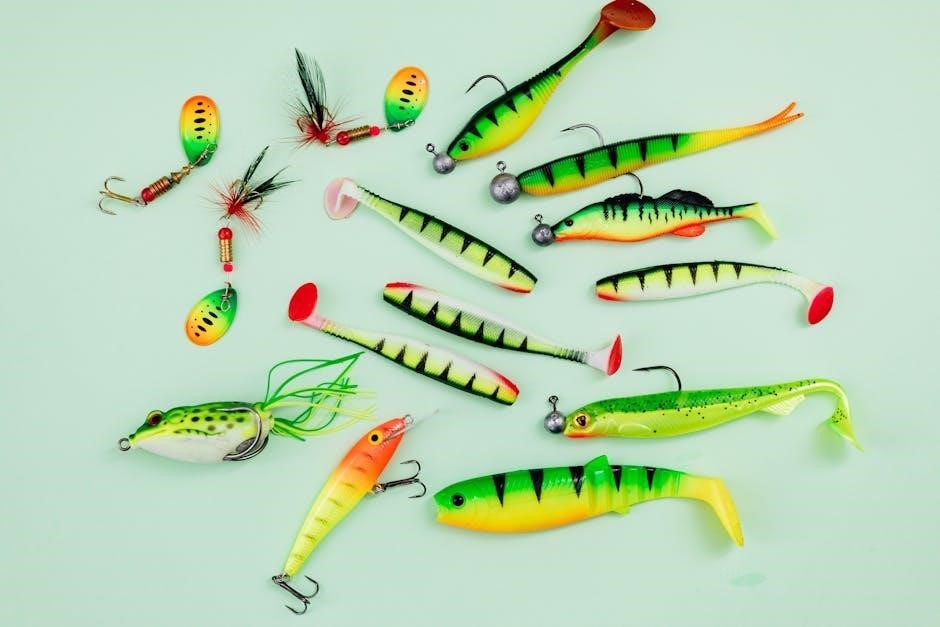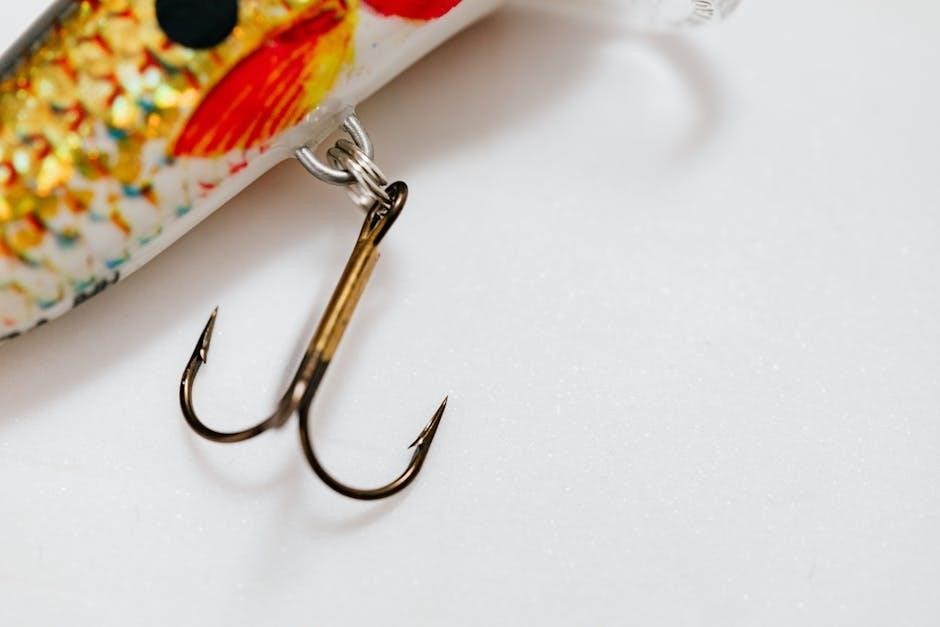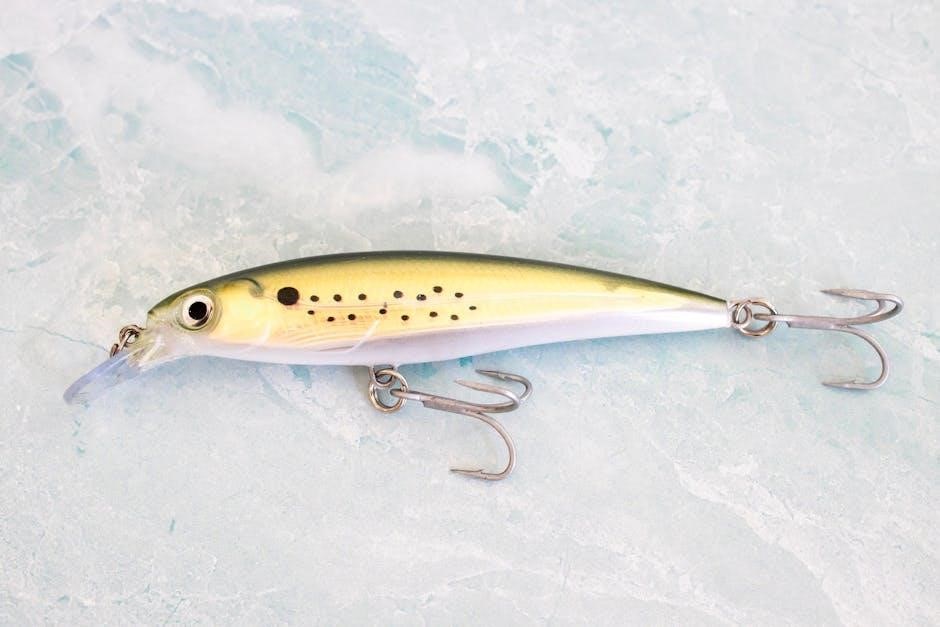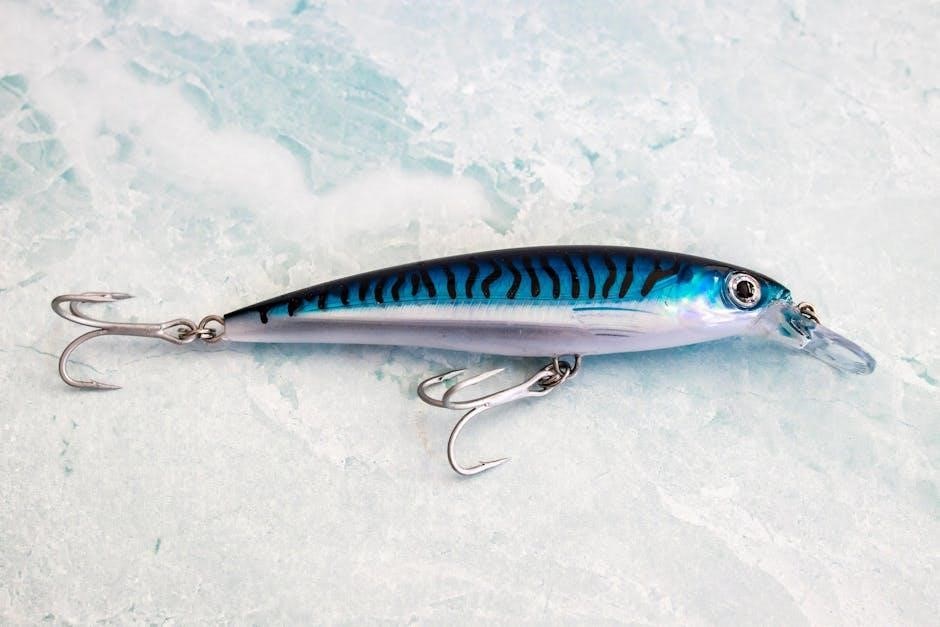
Treble hooks are versatile fishing tools with three points, ideal for various fishing scenarios. They are commonly used in freshwater and saltwater, offering durability and strength for catching different fish species. Their design allows for secure hooking, making them popular among anglers. Available in multiple sizes, selecting the right treble hook size is crucial for effective fishing results.
What Are Treble Hooks?
Treble hooks are fishing hooks featuring three individual points or prongs, designed to increase the chances of hooking fish. Unlike single hooks, their triple design enhances catch rates, especially with lures or bait. These hooks are commonly used in freshwater and saltwater fishing, offering durability and strength. Treble hooks are popular for their versatility, making them ideal for various fishing techniques and target species. Their design ensures secure hooking, making them a favorite among anglers seeking reliable performance.
Importance of Hook Size in Fishing
Hook size plays a critical role in fishing success, as it directly impacts catch rates and fish handling. Proper sizing ensures effective bait presentation and secure hooking, reducing the risk of fish escape. Too large a hook may deter bites, while too small can harm fish or fail to hold. Selecting the right size enhances fishing efficiency, minimizes gear loss, and promotes sustainable angling practices. Thus, understanding hook size is essential for anglers seeking optimal results and ethical fishing experiences.

Understanding Treble Hook Sizes
Treble hook sizes vary significantly, impacting their effectiveness in different fishing scenarios. Standard size charts help anglers choose the right hook for their target species and fishing conditions.

How Hook Sizes Are Measured
Treble hook sizes are determined by a numerical system, where smaller numbers indicate larger hooks. For example, a size 2 hook is bigger than a size 6. Hook measurements consider the gap, shank length, and wire thickness. The gap affects bait presentation, while shank length influences hooking efficiency. Wire thickness determines strength and durability. Proper size selection ensures effective bait presentation and secure hooking, making it a critical factor in successful fishing outcomes for various species and conditions.

Standard Hook Size Chart for Treble Hooks
A standard treble hook chart ranges from size 2 to 14, with size 2 being the largest and size 14 the smallest. Common sizes include 2, 4, 6, 8, and 10. Size 2 and 4 are ideal for large fish like bass or pike, while sizes 6 to 10 suit smaller species like trout or panfish. Hook length typically varies from 8cm to 9.5cm, with specific sizes correlating to bait type and fishing conditions, ensuring optimal performance for diverse fishing scenarios and target species.
Factors Influencing Treble Hook Size
Fish species, bait type, and water conditions significantly influence treble hook size selection. Larger hooks suit bigger fish and heavy-duty fishing, while smaller hooks are better for smaller species and delicate baits.
Fish Species and Target Size
Fish species and their size significantly influence treble hook size selection. Larger hooks, such as size 1 or 2, are ideal for bigger fish like catfish or largemouth bass, while smaller hooks (size 4 or 6) are better suited for smaller species like trout or panfish. The hook size must match the fish’s mouth size to ensure secure hooking and effective fishing. Proper sizing enhances the likelihood of a successful catch and minimizes the risk of damaging the fish or losing it during the fight.
Type of Bait or Lure
The type of bait or lure significantly impacts treble hook size selection. Larger lures, such as spoons or crankbaits, often require bigger hooks (size 1-4) to ensure proper presentation and secure hooking. Smaller lures or live baits, like minnows, work best with smaller hooks (size 6-10) to avoid overwhelming the bait and deterring fish. The hook size should complement the bait’s size and movement, ensuring natural presentation and maximizing the chances of a successful catch.
Fishing Conditions and Water Type
Fishing conditions and water type play a crucial role in selecting treble hook sizes. In clear water, smaller hooks (size 4-6) are less visible, reducing spooking fish. In murky or rough waters, larger hooks (size 2-4) are more effective, ensuring a secure hookset. Additionally, saltwater environments may require stronger hooks due to larger fish and corrosive conditions, while freshwater can often use lighter options. Matching the hook size to the environment ensures better performance and increased success rates.

Pros and Cons of Different Treble Hook Sizes

Small treble hooks offer precision for small fish but may lack durability. Large hooks provide strength for bigger fish but can be bulky and intimidating to smaller species.
Small vs. Large Hooks: When to Use Each
Small treble hooks are ideal for targeting panfish, trout, and other small species, offering precise presentation and reducing the chance of mouth damage. They are also less intimidating to cautious fish. Large hooks, however, are better suited for bigger fish like bass, pike, or catfish, providing durability and strength to handle heavier catches. The choice ultimately depends on the target species, bait size, and fishing conditions to ensure effective hooking and retention.

Hook Strength and Durability
Hooks with 2X heavy wire, like sproat bend designs, are ideal for larger fish, offering superior strength. Barbless hooks minimize catch-and-release damage while maintaining sharpness. High-quality materials ensure durability, preventing bending under pressure. Strong treble hooks are essential for heavy-duty fishing, providing reliability in challenging conditions. Durable coatings or finishes can enhance longevity, resisting corrosion and wear. Proper hook strength ensures secure hooking and reduces the risk of losing fish, making it a critical factor in successful fishing outcomes.

Best Practices for Selecting Treble Hook Size
Selecting the right treble hook size involves matching the bait size, fish species, and water conditions. Proper sizing ensures effective hooking and minimizes fish injury, improving catch rates and sustainability.
Matching the Hook to the Bait
Matching the treble hook size to the bait is crucial for effective fishing. A hook that’s too small may not hold the bait securely, while an oversized hook can deter bites. For larger baits like spoons or plugs, a bigger hook size is appropriate, ensuring the bait moves naturally. Smaller hooks work best for delicate lures or live bait, maintaining a balanced presentation that attracts fish without intimidation.
Considering Fish Behavior and Habitat
Fish behavior and habitat play a significant role in selecting the right treble hook size. Aggressive species like bass may require larger hooks, while cautious fish like trout prefer smaller sizes. In clear water, smaller hooks blend better, while in murky conditions, larger hooks are more effective. Additionally, the structure of the habitat, such as weeds or rocks, influences hook size to avoid snags and ensure proper presentation. Understanding these factors helps anglers make informed decisions for successful fishing.

Treble Hook Size Chart and Recommendations
A treble hook size chart provides correlations for common fish species and scenarios, offering a guide for selecting the right size based on fishing conditions and targets.
Size Correlation for Common Fish Species
Treble hook sizes correlate with target fish species, ensuring effective hooking. Small hooks (size 12-6) suit panfish and trout, while medium sizes (4-2) work for walleye and bass. Larger hooks (4/0-6/0) are ideal for pike, muskie, and catfish. The size ensures the hook matches the fish’s mouth size, preventing injury and increasing catch success. Proper size selection enhances fishing efficiency and minimizes gear damage.
Size Guide for Specific Fishing Scenarios
Treble hook size varies based on fishing conditions and techniques. For lake fishing, sizes 4-6 are ideal for medium-sized fish. In rivers, smaller sizes (8-10) work better for trout and panfish. Offshore fishing requires larger hooks (2/0-4/0) for bigger species. When jigging, use a size 2-4 for walleye, while spoon and crankbait fishing often use sizes 4-6. Match the hook size to water clarity and fish behavior for optimal results and to minimize gear damage.

Common Mistakes in Choosing Treble Hook Size
Over-sizing hooks reduces bites, while under-sizing risks bending or breaking. Ignoring water conditions and fish behavior further compounds selection errors, leading to poor fishing outcomes.
Over-sizing vs. Under-sizing Hooks
Over-sizing hooks reduces the likelihood of bites, as large hooks can be intimidating to fish. Conversely, under-sizing hooks risks them bending or breaking under pressure from larger fish. Using too large a hook for small fish or delicate baits wastes opportunities, while too small a hook may fail to secure bigger catches. Proper hook size ensures effective hooking without deterring fish or compromising durability, balancing performance across various fishing scenarios and target species.
Ignoring Water Conditions and Fish Behavior
Ignoring water conditions and fish behavior can lead to ineffective fishing. Clear water often requires smaller, more discreet hooks, while murky water may demand larger, more visible options. Aggressive fish species like bass may strike larger hooks, while cautious species like trout prefer smaller ones. Failing to adapt hook size to these factors reduces the likelihood of successful bites and hookups, emphasizing the need to tailor choices based on environmental and behavioral cues for optimal results.
Selecting the right treble hook size is crucial for fishing success. Match hooks to fish species, bait size, and water conditions. Durable hooks ensure reliability, while proper sizing enhances catch rates and minimizes gear loss, making informed choices essential for anglers.
Final Tips for Effective Hook Size Selection
When choosing treble hooks, prioritize fish behavior, bait size, and water conditions. Smaller hooks excel for panfish and trout, while larger hooks suit predator species like bass and pike. Ensure hooks are durable, especially for larger fish, and consider barbless options for catch-and-release fishing. Always match hook size to bait proportions to avoid deterring bites. Experiment with different sizes and adapt based on fishing outcomes for optimal results.




